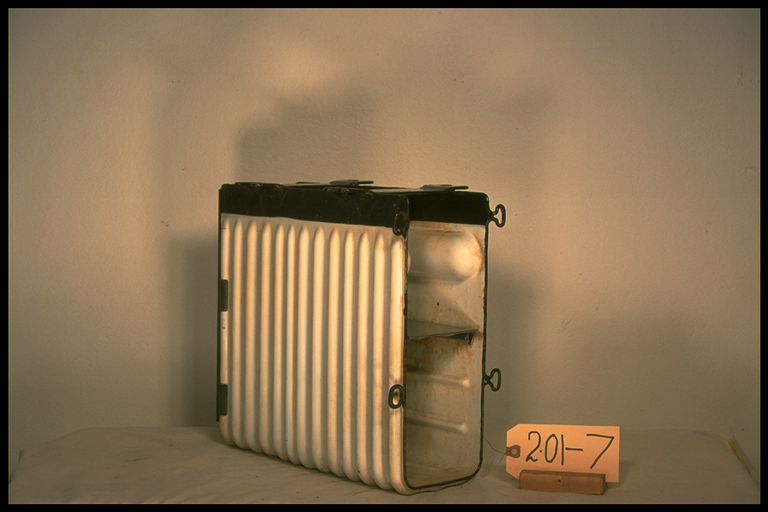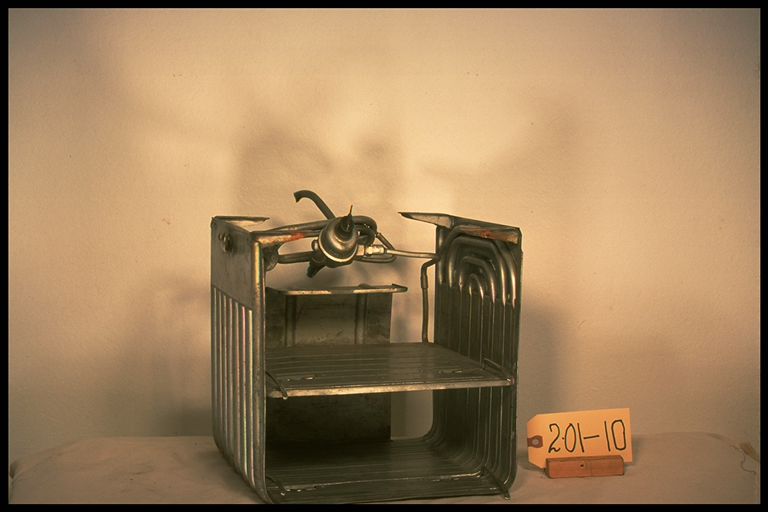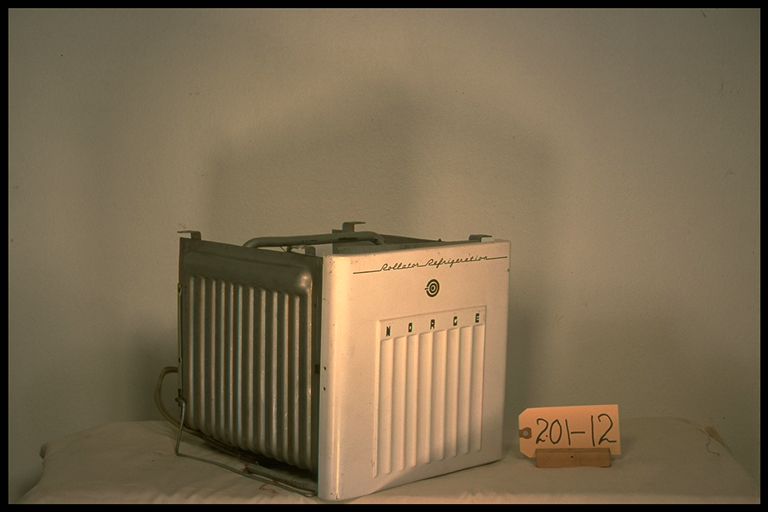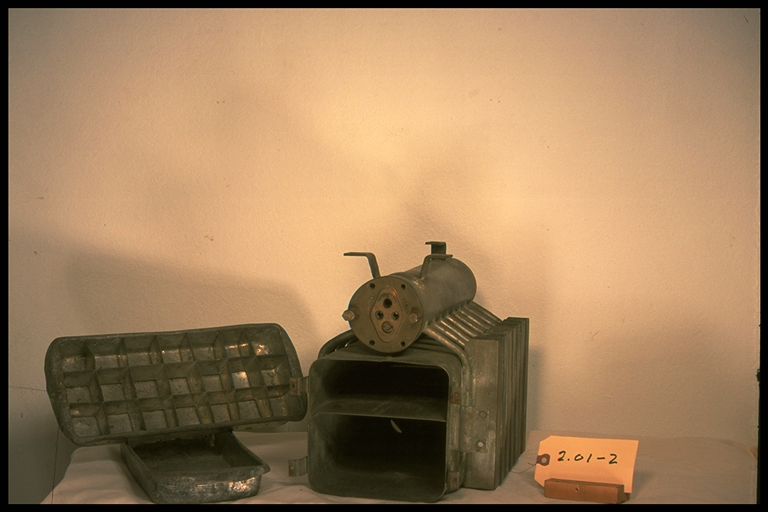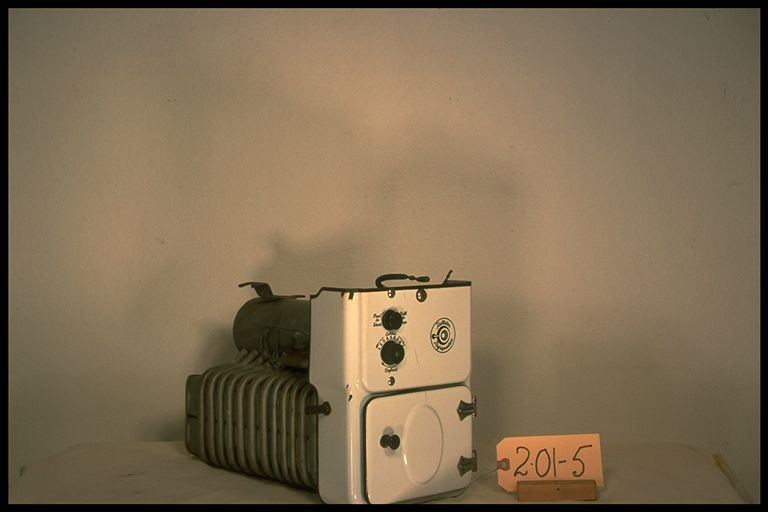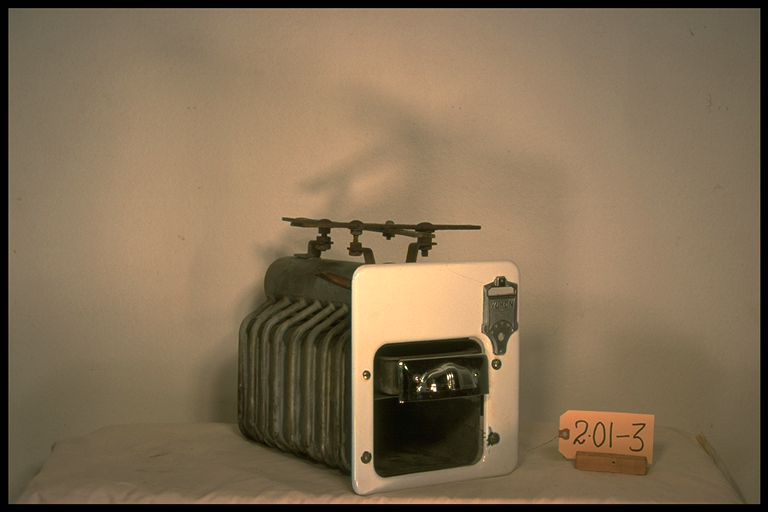2.01-4: Frigidaire 1926 Two Tray, Icemaker with Low-Side Float
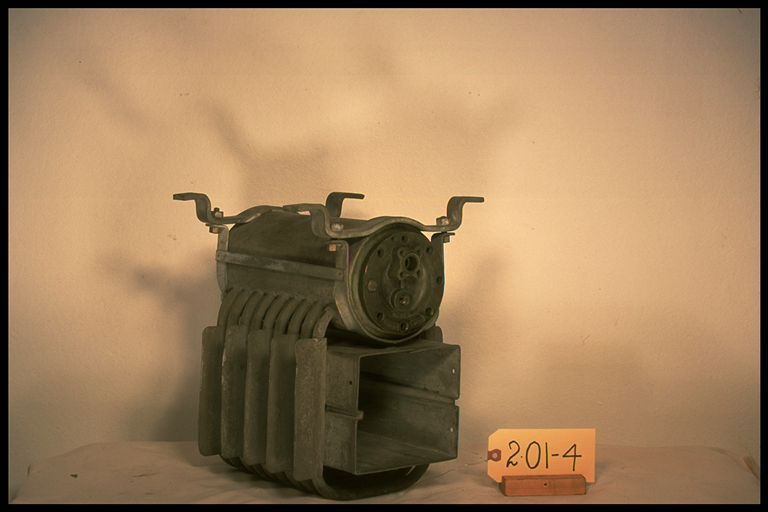
| HHCC Accession No. 2003.013 | HHCC Classification Code: 2.01-4 |
|---|
Description:
Two tray, icemaker evaporator with low-side float; cooling unit for household cabinet refrigerator. Fabricated in tinned copper plate with deep draw brass header , brass flanged float valve calibrated for use on liquid sulphur dioxide. It was temperamental and came previously close to not working at all ‘ and would not have, except for the precision and dedication shown in engineering, materials development and manufacture, as well as in the knowledge and skill of the service man who had to attend to it needs on a regular basis, Frigidaire,1926 [Rev 080320]
Group:
2.01 Refrigerating and Air Conditioning Evaporators - Household
Make:
Frigidaire
Manufacturer:
Frigidaire, USA
Model:
1TF
Serial No.:
Float valve # 9
Size:
9x 11x 13’
Weight:
20 lbs
Circa:
1926
Rating:
Exhibit Quality, very early, Rare
Patent Date/Number:
Provenance:
From York County (York Region) Ontario, once a rich agricultural hinterlands, attracting early settlement in the last years of the 18th century. Located on the north slopes of the Oak Ridges Moraine, within 20 miles of Toronto, the County would also attract early ex-urban development, to be come a wealthy market place for the emerging household and consumer technologies of the early and mid 20th century.
This artifact was discovered in the 1950’s in the used stock of T. H. Oliver, Refrigeration and Electric Sales and Service, Aurora, Ontario, an early worker in the field of agricultural, industrial and consumer technology.
Type and Design:
Flooded evaporator in tinned, heavy copper plate, with brass float chamber, brass, flange mounted float assembly, calibrated for S02 refrigerant, 9 pass 1/2 copper coil distributing tubes, with right and left side plate fins. .Equipped with 2 very crude, brake formed, heavy copper, tinned sheet stock, Two ice cube trays with one removable ice cube grid, 18 cubes
Construction:
Material:
Special Features:
Accessories:
Two ice cube trays, one shallow, one deep for frozen food Liquid and suction shut off valves not included
Capacities:
Frigidaire rated this evaporator for 2 trays of ice cubes, 18 per tray for 51 lbs of ice per filling
Performance Characteristics:
Operation:
Requires 5 lbs of So2 to fully flood the coil, with a total systems charge of possibly double that - enough refrigerant gas to make a leak very unpleasant in the household.
Control and Regulation:
Targeted Market Segment:
Consumer Acceptance:
Merchandising:
Market Price:
Technological Significance:
The technological significance of the evaporator in a mechanical refrigeration system lies in its ability to evaporate liquid refrigerant (allowing it to absorb latent heat and thus perform useful cooling). In the public mind, however, the useful work was more simply that of cooling.
This lead astute manufactures to popularise the use of the term ‘cooling unit’ in place of evaporator. It was the term adopted by the industry in the early years, as it attempted to connect with the human experience of the times to better promote its wares, gaining market share in the embryonic years of Canada’s emerging consumer society. (See examples in early sale literature from the Kelvinator Co. of Canada)
Human experience and the social culture of the 1920’s also associated useful cooling with the melting of ice. Historically manufactures successfully played to this sense of public understanding by further marketing cooling units as icemakers. By this means they appealed to wide spread cultural understandings of how things got cooled, through the controlled melting of ice (the popular Canadian icebox of the 1920’s and 30’s). In a peculiar twist, it was often the job of the refrigeration sales or service man to explain to the homemaker that it was not really the ice in the ice cube trays that cooled the refrigerator, but the motor and compressor underneath.
In the 1920’s manufactures of mechanical refrigerators for the home appealed to the consumer public by promoting ice and ice cream as the new consumables, the new food sensations available for all those sufficiently affluent to enjoy the experience. Promotional literature focused on the pleasant sensation of ice cold beverages and on ice cream making at home ‘ using the latest cooling unit. A recipe and food life style book came with the refrigerator for the edification and instruction of the homemaker (See examples in early sale literature from the Kelvinator Co. of Canada). Ice and ice cream making in the home was, in fact, one of the significant, new ‘Gee whiz’, household technologies of the times.
This specimen is a particularly early, a well-preserved sample of cooling unit art form (Frigidaire shows this evaporator as discontinued May 5, 1928). Crude in manufacturing techniques, by subsequent standards, the industry would move quickly to modernise the look of its products and to develop the materials and manufacturing processes needed to produce them. (See for example items 011 and 012)
Industrial Significance:
Socio-economic Significance:
Socio-cultural Significance:
Donor:
G. Leslie Oliver, The T. H. Oliver HVACR Collection
HHCC Storage Location:
Tracking:
Bibliographic References:
See Frigidaire Installation and Service Manual SER-405, for products before 1937, PP20-25
Notes:
Note #1: Frigidaire shows this evaporator as discontinued May 5, 1928
